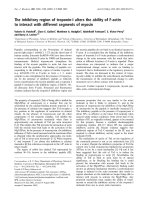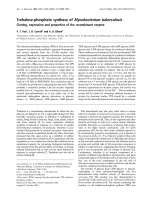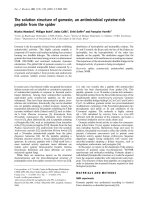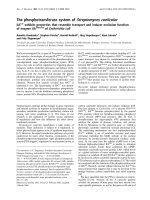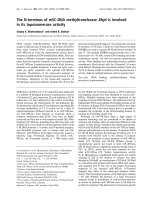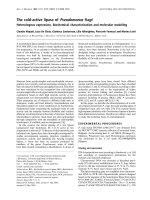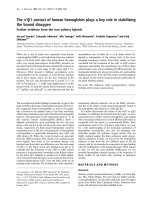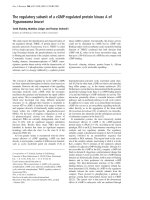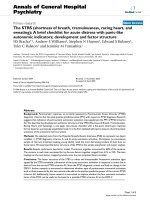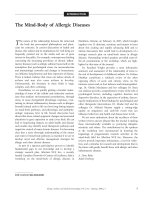Báo cáo Y học: The cold-active lipase of Pseudomonas fragi Heterologous expression, biochemical characterization and molecular modeling pdf
Bạn đang xem bản rút gọn của tài liệu. Xem và tải ngay bản đầy đủ của tài liệu tại đây (370.9 KB, 8 trang )
The cold-active lipase of
Pseudomonas fragi
Heterologous expression, biochemical characterization and molecular modeling
Claudia Alquati, Luca De Gioia, Gianluca Santarossa, Lilia Alberghina, Piercarlo Fantucci and Marina Lotti
Dipartimento di Biotecnologie e Bioscienze, Universita
`
degli Studi di Milano-Bicocca, Milano, Italy
A recombinant lipase cloned from Pseudomonas fragi strain
IFO 3458 (PFL) was found to retain significant activity at
low temperature. In an attempt to elucidate the structural
basis of this behaviour, a model of its three-dimensional
structure was built by homology and compared with
homologous mesophilic lipases, i.e. the Pseudomonas
aeruginosa lipase (45% sequence identity) and Burkholderia
cepacia lipase (38%). In this model, features common to all
known lipases have been identified, such as the catalytic triad
(S83, D238 and H260) and the oxyanion hole (L17, Q84).
Structural modifications recurrent in cold-adaptation, i.e. a
large amount of charged residues exposed at the protein
surface, have been detected. Noteworthy is the lack of a
disulphide bridge conserved in homologous Pseudomonas
lipases that may contribute to increased conformational
flexibility of the cold-active enzyme.
Keywords: lipase; Pseudomonas; cold-active enzymes;
modeling; selectivity.
Enzymes from psychrotrophic and psychrophilic microor-
ganisms have recently received increasing attention, due to
their relevanceforboth basic and applied research. This effort
has been stimulated by the recognition that cold-adapted
enzymes might offer novel opportunities for biotechnological
exploitation based on their high catalytic activity at low
temperatures, low thermostability and unusual specificities.
These properties are of interest in different fields such as
detergents, textile and food industry, bioremediation and
biocatalysis under low water conditions [1,2]. Furthermore,
fundamental issues concerning the molecular basis of cold
activity and the interplay between flexibility and catalytic
efficiency areof importance inthe study ofstructure–function
relationships in proteins. Such issues are often approached
through comparison with the mesophilic or thermophilic
counterparts, if available, and/or mutagenesis [3,4].
In this context, the recent cloning of a few lipases
(acylglycerol ester hydrolases, EC 3.1.1.3) active at low
temperature is relevant [5–7]. Because of their metabolic and
industrial role, lipases have been thoroughly investigated by
studies encompassing sequence, structure, regulation of
expression, activity and specificity [8]. Among bacterial
lipases, a focus has been on enzymes produced by
members of the genus Pseudomonas, some of which
have been recently reclassified as Burkholderia. A dozen of
lipase-encoding genes have been cloned from different
species, and the corresponding proteins have been classified
into families I.1 and I.2 of bacterial lipases according to their
molecular properties and to the requirement of helper
proteins for correct folding and secretion [9]. Crystal
structure determinations of Pseudomonas lipases have been
reported including B. glumae (BGL) [10], P. aeruginosa
(PAL) [11], and B. cepacia (BCL) [12–14].
In this paper, we describe the characterization of a cold-
active lipase cloned from P. fragi, the main spoiling agent of
refrigerated meat and raw milk [15]. This enzyme shares
high sequence similarity with Pseudomonas lipases of known
three-dimensional structure, therefore providing a new tool
to study the molecular bases of cold-adaptation.
EXPERIMENTAL PROCEDURES
P. fragi strain IFO3458 (LMG2191
T
) was obtained from
the BCCM
TM
/LMG bacteria collection (Universiteit Gent,
Belgium). As the cloning host, E. coli JM101 (Promega Co,
Madison, Wisconsin) was used. Heterologous expression
was performed in the E. coli strain SG13009[pREP4]
(Qiagen).
Cloning and expression
DNA manipulations were according to Sambrook et al. [16]
and according to manufacturer’s instructions for the
enzymes and materials employed.
Chromosomal DNA was extracted as described previ-
ously [17] with minor modifications from a P. fragi culture
grown to the late exponential phase at 25 °Cin1%bacto
tryptone, 0.5% bacto yeast extract and 0.5% NaCl.
The lipase-encoding gene was amplified from chromoso-
mal DNA by PCR with oligonucleotide primers designed
based on the sequence of the homologous lipase from strain
IFO 12049 (AC X14033). Forward primer: 5¢-CACCCTG
CGAGATTGAACATG-3¢ (nucleotides )18 to+3); reverse
primer: 5¢-AAGCTTGATTACAGGCTACAAG-3¢ (+938
Correspondence to M. Lotti, Dipartimento di Biotecnologie
e Bioscienze, Universita
`
degli Studi di Milano-Bicocca,
Piazza della Scienza 2, 20126 Milano, Italy.
Fax: + 39 02 64483565, Tel.: + 39 02 64483527,
E-mail:
Abbreviations:BCL,Burkholderia cepacia lipase; BGL, Burkholderia
glumae lipase; MM, molecular mechanics; PAL, Pseudomonas
aeruginosa lipase; PFL, Pseudomonas fragi lipase; PCR, polymerase
chain reaction; SRC, structural conserved regions.
Enzyme: lipase (EC 3.1.1.3).
(Received 18 February 2002, revised 17 May 2002,
accepted 23 May 2002)
Eur. J. Biochem. 269, 3321–3328 (2002) Ó FEBS 2002 doi:10.1046/j.1432-1033.2002.03012.x
to +924), where a restriction site for HindIII was inserted.
Reaction was carried out in a total volume of 100 lLandwas
catalyzed by 2.5 U of Pfu TurboTM polymerase (Stratagene,
CA, USA). The amplification program was as follows:
3min94°C followed by 25 cycles of 30 s 94 °C, 45 s 55 °C,
1min 72°C, the final elongation step was 5 min 72 °C
and 15 min 10 °C. The amplified fragment, purified from a
0.8% agarose gel, was automatically sequenced by
M-Medical (Firenze, Italy).
The lipase-encoding gene was inserted in the BamHI and
HindIII cloning sites of pQE
30
(Qiagen), a plasmid designed
for the regulated expression in E. coli of foreign genes.
Recombinant proteins are produced as fusion with a His
6
tag at the N-terminus. The gene was amplified as before and
modified by: (a) introducing a BamHI site and deleting the
starting ATG codon and (b) introducing a HindIII cleavage
site at the 3¢ end. Primers were as follows: forward primer:
5¢-GGATCCGACGATTCGGTAAAT-3¢; reverse primer:
5¢-AAGCTTGATTACAGGCTACAAG-3¢.
E. coli SG13009 transformed with the expression plasmid
was grown overnight at 27 °C in Luria–Bertani medium
supplemented with 100 lgÆmL
)1
ampicillin and 25 lgÆmL
)1
kanamycin. Isopropyl thio-b-
D
-galactoside was added to a
concentration of 0.4 m
M
and cultivation was continued for
an additional 4 h. Cells were collected by centrifugation
(30 min, 8000 g,4°C) and resuspended in 50 m
M
NaH
2
PO
4
pH 8.0, 300 m
M
NaCl and 10 m
M
imidazole.
After the addition of 1 mgÆmL
)1
lysozyme, the suspension
was incubated on ice for 30 min and then sonicated six times
for 10 s. The cell lysate was centrifuged for 20 min at 4 °C,
25 000 g.TheHis
6
-tagged lipase was purified at 4 °Con
50% Ni-nitrilotriacetic acid resin (Qiagen). Two mililiters of
clear lysate were added to 1 mL resin, mixed by gentle
shaking at 4 °C for 60 min and loaded on a column. After
washing with 4 mL of 50 m
M
NaH
2
PO
4
pH 8.0, 300 m
M
NaCl and 20 m
M
imidazole, the recombinant lipase was
eluted at pH 7.5 with 2 mL of 50 m
M
NaH
2
PO
4
,300m
M
NaCl and 250 m
M
imidazole. Purification of the recombin-
ant protein was monitored spectrophotometrically follow-
ing the increase in absorbance at 410 nm due to hydrolysis
of p-nitro-phenylpalmitate. The reaction mixture (1 mL)
contained 0.8 m
M
p-nitro-phenylpalmitate in 50 m
M
Na
2
HPO
4
Æ2H
2
O, KH
2
PO
4
with 2% arabic gum.
Protein characterization
SDS PAGE [18] was performed using 12% acrylamide gels
with GELCODE staining (Pierce). The protein concentra-
tion was determined according to Bradford [19] with BSA as
the standard.
Lipase activity was determined in a pH-stat assay by
titrating fatty acids released from triacylglycerols with
0.01
M
sodium hydroxide using a 718 STAT TITRINO
(Metrhom). Emulsions of 20 m
M
triacylglycerols with 2%
arabic gum were used as the substrate. Tricaprylin was the
substrate for activity determination, if not otherwise stated.
The pH and temperature optima were investigated in the
range of 4–9 and 25–40 °C, respectively. Substrate speci-
ficity was determined at 29 °C, pH 8.0 on triacylglycerol
substrates with chain lengths ranging from C
4
to C
18
.The
effect of temperature on stability was determined by
preincubating samples of purified rPFL at 10°,27° and
50 °C before determining residual activity.
The effect of calcium ions on activity was investigated
under standard assay conditions by measuring enzymatic
activity in the presence of 5 m
M
EDTA at free calcium
concentrations varying between 0 and 50 m
M
.
Molecular modeling
Multiple sequence alignments were carried out with the
program
CLUSTALX
[20] using the following lipase
sequences: P. aeruginosa (PAL, Swissprot code: P26876),
B. glumae (BGL, Swissprot code: O05489), B. cepacia
(BCL, Swissprot code: P22088), P. fragi (PFL, this work).
The alignment featuring the highest score was obtained
using the Blosum matrix [21] and standard
CLUSTALX
parameters. The atomic coordinates of PAL and BCL in
their open conformation [11,13] were obtained from the
Brookhaven Protein Data Bank.
The PFL three-dimensional model was built according
to the following procedure: (a) protein regions charac-
terized by high similarity, as identified by sequence
alignment and featuring very similar secondary structure,
as derived from experimental data or as predicted by the
PHD algorithm [22], were chosen as structurally con-
served regions (SCR); (b) the atomic coordinates of the
backbone atoms inside the SCR regions were transferred
from the reference X-ray structure to the model; (c)
fragments connecting the scaffold elements (usually
loops) were modeled scanning the Brookhaven Protein
Databank for protein structures of a predefined length
that would fit properly into the model protein between
two SCRs. The search was carried out by comparing the
a-carbon distance matrix of the flanking SCR peptides
with a precalculated matrix for all known proteins that
have the same number of flanking residues and an
intervening peptide segment of the given length. The
following strategy has been adopted to optimize the
structure of the model: (a) all atoms, except those
corresponding to the fragments connecting SCRs, were
kept fixed during the first Molecular Mechanics (MM)
energy minimization. This allowed the nonSCR elements
to re-arrange their conformation without affecting the
global folding of the more conserved regions. (b) In a
second MM optimization step, only the backbone atoms
of the SCRs were kept fixed. (c) Only the a-carbons of
the SCR regions were constrained to their initial position
and (d) as the final step, the whole model was subjected
to MM optimization without constraints. The optimized
structure was subjected to the program
PROCHECK
[23],
which allowed confirming its structural reliability.
RESULTS AND DISCUSSION
Sequence analysis
Lipases have been cloned from a few P. fragi strains [24–26].
Out of them, the short lipase sequence (135 residues) from
strain IFO3458 present in the database ([24]; AC: M14604)
is probably truncated at its 3¢ half as it lacks functional sites.
The coding sequence was therefore amplified from chro-
mosomal DNA with oligonucleotide primers designed
based on the sequences immediately upstream and down-
stream the coding sequence of the lipase from the related
strain IFO12049 (S02005) [25].
3322 C. Alquati et al. (Eur. J. Biochem. 269) Ó FEBS 2002
Sequencing revealed an ORF of 879 bp encoding a
polypeptide of 293 residues. Comparison with M14604
evidences a sequencing error at bp 354 where a missing
nucleotide causes a reading frameshift followed by an early
stop codon after few amino acids. The revised sequence has
been assigned accession number AJ250176. Total GC
content (59.3%) and the predicted codon usage, with
72.2% of the codons ending with G or C, are characteristic
of Pseudomonas genes. Analysis of the deduced amino-acid
sequence is consistent with a protein of M
r
32.086 and an
isoelectric point of 9.33. A single cysteine residue is present
at position 39, thus ruling out the presence of a disulphide
bridge, characteristic of most Pseudomonas lipases. A leader
sequence for secretion could not be unambiguously identi-
fied at the N-terminal end.
The amino-acid sequence shares 97% identity with IFO
12049 lipase from which it only diverges in its C-terminal 22
residues (highlighted in Fig. 1). Scanning of protein
sequence databases by
FASTA
[27] revealed a high degree
of similarity with the P. fluorescens strain C9 (O68310,
48.1% identity over 297 amino acids), Proteus vulgaris
(Q52614, 47.9% over 286 amino acids), Pseudomonas sp.
(Q9X512, 47.2% over 290 amino acids), P. aeruginosa
(Q9L6C7, 45.1% over 288 amino acids) and Vibrio cholerae
(P15493, 48,2% over 288 amino acids) lipases. High identity
is also shared with other Pseudomonas lipases of known
three-dimensional structure, i.e. B. cepacia (37.7% over 318
amino acids), and B. glumae (37.9% over 322 amino acids).
The similarity with P. fluorescens lipases is restricted to a
30-kDa enzyme recently isolated from milk [15] and does
not extend to the 50-kDa P. fluorescens lipases described so
far. Surprisingly, the remarkable similarity to the lipase
from Proteus vulgaris K80 [28], that in addition shares with
PFL the absence of cysteine residues possibly involved in
intramolecular disulphide bond formation.
On the other hand, the lipase sequence does not display
obvious sequence similarity with either a lipase cloned from
an alaskan psychrotrophic Pseudomonas [5] or with other
cold-adapted lipases from different microorganisms [6,7].
Expression and purification
Expression of rPFL carrying a His
6
tag at its N-terminus
was obtained as described above. Culture growth and
induction was performed at 27 °C to cope with both enzyme
thermolability and the optimal growth temperature for the
E. coli expression system. Under these conditions, rPFL
was partly obtained in a soluble, active form suitable for
further characterization. About 2 mg of pure recombinant
rPFL per g wet weight cells were recovered by a one-step
purification method involving metal-chelating chromatog-
raphy (Fig. 2). In order to exclude any influence of the His
6
tag on the recombinant lipase activity, a control plasmid
was constructed where the tag was followed by a recognition
site for Tev protease. Enzyme obtained by protease
digestion did not show any difference in activity (not
shown).
Several Pseudomonas lipases have been reported to
require a chaperone (or helper) protein for efficient secretion
and folding of the active lipase [9]. Therefore, coexpression
of the lipase- and helper-encoding genes has been success-
fully exploited as a tool to obtain high levels of recombinant
active lipase in heterologous bacterial hosts [29]. However,
coexpression of rPFL with the foldase of P. aeruginosa did
Fig. 1. Alignment of the PFL sequence with Pseudomonas lipases of known three-dimensional structure. The sequence is identical to that of the lipase
from strain IFO12049 except for the C-terminal 22 amino acids which are shown in bold.
ˆ
¼ amino acid forming the catalytic triad, ° ¼ amino
acid forming the LID, § ¼ amino acid involved in calcium binding. PAL ¼ P. aeruginosa lipase, PFL ¼ P. fragi lipase, BCL ¼ B. cepacia lipase
and BGL ¼ B. glumae lipase.
Ó FEBS 2002 Cold-active Pseudomonas fragi lipase (Eur. J. Biochem. 269) 3323
not produce significant improvements in the fraction of
soluble lipase. The apparent ineffectiveness of foldase
together with the lack of a signal peptide at the N-terminal
suggests the hypothesis that PFL might be secreted by a
signal peptide-independent pathway and calls for further
investigation on this subject.
Enzyme activity and specificity
In the standard tricaprylin hydrolysis assay, rPFL displayed
highest activity at 29 °C and pH 8.0, in good agreement
with results reported for the wild type enzyme [30].
Interestingly, the enzyme lost most of its activity at 50 °C
but retained about 60% of its specific activity at 10 °C
(Table 1). Under the same conditions, the activity of the
homologous lipase from Burkholderia cepacia was reduced
to 10% (not shown). The stability of rPFL was further
investigated. Incubation of the enzyme at different temper-
atures showed that at 10 °C rPFL retains for several hours
most of its activity, whereas its half-life at 27 °C is about
5 h. Activity dramatically drops after a few minutes at
50 °C (Fig. 3). This is an important characteristic for PFL
identification as a cold-active enzyme and well fits with the
structural features evidenced by the three-dimensional
model, as reported below.
Specificity towards triglycerides was tested in a pH-stat
assay using six triacylglycerol substrates of different chain
length (C
4
to C
18
). As shown in Fig. 4, rPFL activity
decreases going from short- to long-chain substrates and
triolein is a poor substrate. Therefore, PFL differs in chain
length selectivity from both PAL, with broad substrate
specificity on triglycerides [31] and BCL which shows a high
preference for the hydrolysis of triglycerides with a chain
length ‡ 8 [32]. No activity was detected in a phospholipase
assay using phosphatidylcholine as the substrate.
Finally, experiments have been carried out to elucidate
the influence of Ca
2+
ions on the catalytic activity. rPFL
activity measured in the presence of 5 m
M
EDTA was by
55% lower than the control. Variation of the calcium
concentration resulted in a saturation curve with a plateau
between 10 m
M
and 20 m
M
calcium (Fig. 5).
Fig. 3. Effect of temperature on the enzyme stability as measured at
10 °C(d), 27 °C(r)and50°C(m).
Fig. 4. Activity of rPFL on triacylglycerols with different chain length.
C4, C8, C12, C16, C18 and C18* are tributyrin, tricaprylin, trilaurin,
tripalmitin, tristearin and triolein, respectively.
Fig. 5. Enzymatic activity of rPFL as a function of calcium concentra-
tion.
Fig. 2. Electrophoretic analysis showing the purification of recombinant
PFL. (1) Molecular mass standards; (2) 2 lg rPFL after purification by
metal-chelating chromatograpy; (3) total soluble extract of E. coli
expressing the recombinant protein.
Table 1. Rate of hydrolysis of tricaprylin by rPFL at different temper-
atures.
Temperature of hydrolysis (°C)
10 29 50
Relative hydrolysis (%) 59 100 15
3324 C. Alquati et al. (Eur. J. Biochem. 269) Ó FEBS 2002
Model building
In order to derive a three-dimensional model of the PFL
structure, its sequence was aligned with those of Pseudo-
monas lipases of known three-dimensional structure, namely
B. cepacia (BCL), B. glumae (BGL) and P. aeruginosa
(PAL). As can be observed in Fig. 1, sequence similarity
extends along all the protein sequence with the exception of
the 177–213 region (PFL numbering) where the BCL and
BGL sequences are characterized by peptide insertions. Use
of secondary structure data allowed to better define SCR in
regions where sequence similarity alone provided ambigu-
ous results. Using this approach, 11 SCRs were defined that
constitute the structural scaffold upon which the PFL three-
dimensional model was built. These SCRs span the peptide
segments 5–23, 31–49, 54–68, 76–120, 129–148, 155–181,
191–201, 214–218, 237–242, 245–267 and 277–293 of PFL.
It is interesting to note that most nonSCRs are peptide
fragments forming loop regions in the experimentally
derived three-dimensional structures, supporting our choice
of SCRs. On the other hand, regions forming important
structural and/or functional portions in the selected lipases,
such as the catalytic triad, the oxyanion hole and the
calcium binding site are all located in SCRs.
In this work, PAL was chosen as structural reference as
this enzyme shows the highest degree of similarity to PFL.
Furthermore, the computed structure was validated against
the BCL structure. We observed that our PFL model might
overlap to a high degree with both structures, as expected
from the overall structural similarity relating PAL and BCL
[11]. On these bases, the structural features of the PFL were
analysed in deeper detail (Figs 6–8).
Fig. 6. Overall three-dimensional structure of PFL, as obtained by
homology modeling. For clarity, only arginine side chains are explicitly
shown.
Fig. 7. Schematic representation of the Ca-coordination environment in
PFL. The conserved residues D217 and D262 are coordinated to the
metal ion by one carboxylic oxygen atom belonging to the side chain.
The Ca ion is coordinated also by the backbone carbonyl groups of
H266 and R269. Bond distances and angles involving the metal atom
and the coordinating amino acids are very similar to the corresponding
values observed in PAL (data not shown).
Fig. 8. Schematic representation of the two aromatic residues of PFL
(W184 and F244) that structurally correspond to the disulphide bridge in
PAL, shown in grey.
Ó FEBS 2002 Cold-active Pseudomonas fragi lipase (Eur. J. Biochem. 269) 3325
Amino acids forming the catalytic center in PAL and
BCL are conserved in PFL and correspond to S83, D238
and H260. However, some subtle structural differences
between the active sites are worth noting. PFL is charac-
terized by a hydrogen bond between D259 and H260, which
is not present either in PAL nor BCL; the proximal
carboxylic acid suggested to function as an alternative
proton acceptor in other Pseudomonas lipases (E289, BCL
numbering) [33] is not conserved in PFL nor does the
analysis of its model reveal other glutamate or aspartate
residues in that region.
Another feature characterizing lipases is the so-called
oxyanion hole, an arrangement of amino acids which plays
an important role in the stabilization of the tetrahedral
intermediate transiently formed in the hydrolysis reaction
through hydrogen bonding to main chain donors [34]. Even
in this case, two residues that might contribute to the
formation of the stabilizing configuration (L17 and Q84,
PFL numbering) are conserved and located in SCRs.
In most lipases, the catalytic site is occluded by a surface
amphiphilic structure, named the lid, that makes the active
site inaccessible to the substrate, unless it is displaced by the
interaction with aggregated substrates. The region forming
the lid is located in a SCR and appears to be well conserved
in PFL (128–148).
A further target for investigation was the presence of a
binding site for Ca
2+
ions, which are reported to enhance
the activity of several bacterial lipases. Accordingly, a
calcium binding pocket is present both in PAL and BCL,
where its function seems to be rather related to structure
stabilization [11,13]. The crucial features of the calcium
binding site are well conserved in PFL, where D217 and
D262 are favourably located to interact with the metal by
their side chain carboxylic groups (Fig. 7). Moreover, two
other amino acids (H266 and R269, PFL numbering), even
if different from the corresponding residues of BCL and
PAL, have a proper structural orientation of the backbone
carbonyl groups to bind the metal ion. However, some
subtle differences in the Ca
2+
coordination environment are
observed in the three considered lipases. In PAL (and BCL),
one of the water molecules coordinated to the Ca
2+
ion is
also involved in hydrogen bonds with the side-chains of
S211 and D212 (S244 and T245 in BCL). In PFL, these
residues are substituted by L219 and H220. Due to the
hydrophobic nature of leucine, the binding energy of the
water molecule is expected to be smaller in PFL than in
PAL and BCL. Moreover, in BCL a water molecule
interacts with a large loop (A213–N239) and is coordinated
to the Ca
2+
ion. In PAL the corresponding loop (S202–
F207) is shorter and the water molecule in the coordination
sphere of the metal is substituted by the OH group of T205.
In PFL, the loop (A210–L215) has geometry features
similar to PAL but T205 is substituted by the hydrophobic
residue L213, suggesting a weaker coordination to the metal
ion.
The enzyme–substrate interaction has been studied in
detail for PAL and BCL crystallized in complex with the
same tryglyceride-like inhibitor [11,14] For both enzymes,
the substrate binding pocket has been shown to consist of a
cleft mostly lined by hydrophobic amino-acid side chains
and residues relevant for substrate recognition have been
identified. In this context, a comparison between PFL and
BCL shows important differences in their preference
towards short and long chain acyl substrates. A structural
comparison suggests features that are responsible for these
differences. Interesting substitutions are located at the
entrance of the substrate binding funnel (V123 with L119
and F249 with R224) and within the binding pocket where
T18, F119, A247 and T251 in BCL are substituted in PFL
by F, L, N and V residues, respectively. Site-directed
mutagenesis is required to elucidate the relevance of the
observed aminoacid substitutions.
PFL structure was then analysed with the aim of
explaining PFL activity at low temperature observed in
this study. The path followed during evolution to ÔdesignÕ
cold adapted enzymes is still not completely understood.
However, the number of disulphide bridges, the location of
proline and arginine residues, and hydrophobic core
interactions are generally recognized as key factors in
determining the flexibility of the enzyme molecule and, as a
consequence, its catalytic activity at different temperatures
[2]. One of the most striking differences between PAL, BCL
and PFL concerns the number of arginine residues, 11, 9
and 24, respectively. In PFL, 20 out of 24 arginine residues
are almost evenly distributed on the surface of the protein
(Fig. 6) and only two of them are involved in intramolecular
salt bridges. Therefore, PFL is characterized by the
abundance of charged residues on the surface which
enhances flexibility and ability of interaction with the
solvent [3]. Both factors are of importance for cold activity.
On the other hand, the presence of disulphide bridges may
increase the rigidity of the protein backbone and therefore
its thermostability [35]. Interestingly, the only disulphide
bridge present in BCL and PAL is missing in the PFL,
where only one cysteine residue is present. Recently, it has
been shown that CysfiSer mutants of PAL are more
sensitive to heat denaturation, confirming a stabilizing role
for the PAL disulphide bond [36]. Moreover, the analysis of
the three-dimensional structure of PFL allow to observe
that two aromatic residues (W184 and F244), that struc-
turally correspond to the disulphide bridge in BCL, are
involved in a stacking interaction (Fig. 8), with a moderate
stabilizing effect on this portion of the protein. Finally,
distribution of proline residues was considered, as it has
been suggested that conformationally rigid proline residues
in loops and turns might increase the rigidity of a protein
and decrease its catalytic efficiency at low temperature [35].
PAL, BCL and PFL all contain 13 proline residues, eight of
which are located in conserved regions. Other prolines are
mainly located in loop regions of PAL and BCL, whereas
only one is in a loop in PFL. Again, this suggests an
increased conformational flexibility for the latter enzyme.
CONCLUSIONS
The P. fragi lipase characterized in this study is a new
example of cold-active lipase and provides a model for
studying the molecular basis of cold adaptation. In fact,
comparison of proteins from organisms belonging to
divergent evolutionary lineages might confuse the analysis
of structural differences of relevance which are masked by
substitutions arose from evolutionary divergence [37]. Other
examples of psychrophilic lipases are reported in the
literature, one of which has been cloned from Pseudomon-
ads. However, such lipases are related in sequence to each
other but not to any mesophilic lipase. In contrast, PFL can
3326 C. Alquati et al. (Eur. J. Biochem. 269) Ó FEBS 2002
be classified in a group of bacterial lipases well character-
ized from the biochemical and structural point of view.
Comparison of the three-dimensional model with the
structures of mesophilic homologous lipases accounts for
PFL activity at low temperature, in the frame of the largely
accepted assumption that relates cold adaptation to changes
in the protein conformational flexibility. This study high-
lights relevant features in the PFL structure, such as a
reduced number of disulphide bridges and of prolines in
loop structures. Arginine residues are distributed differently
than in mesophilic enzymes, with only a few residues
involved in stabilizing intramolecular salt bridges and a
large proportion of them exposed at the protein surface and
therefore able to interact with the solvent enhancing
flexibility.
ACKNOWLEDGEMENTS
This work was supported by a grant of the Progetto Finalizzato
Biotecnologie of the Italian National Research Council to L. A. We
also acknowledge contribution from the Vigoni Program. The authors
wish to thank K E. Jaeger for helpful discussion and for providing the
P. aeruginosa foldase-encoding gene.
REFERENCES
1. Gerday, C., Aittaleb, M., Bentahir, M., Chessa, J.P., Claverie, P.,
Collins, T., D’Amico, S., Dumont, J., Garsoux, G., Georlette, D.,
Hoyoux, A., Lonhienne, T., Meuwis, M.A. & Feller, G. (2000)
Cold-adapted enzymes: from fundamentals to biotechnology.
Trends Biotechnol. 18, 103–107.
2. Russell, N.J. (2000) Toward a molecular understanding of cold
activity of enzymes from psychrophiles. Extremophiles 4, 83–90.
3. Narinx, E., Baise, E. & Gerday, C. (1997) Subtilisin from psy-
chrophilic antarctic bacteria: characterization and site-directed
mutagenesis of residues possibly involved in the adaptation to
cold. Protein Eng. 10, 1271–1279.
4. Wintrode, P.L., Miyazaki, K. & Arnold, F.H. (2000) Cold adap-
tation of a mesophilic subtilisin-like protease by laboratory evo-
lution. J. Biol. Chem. 275, 31635–31640.
5. Choo, D W., Kurihara, T., Suzuki, T., Soda, K. & Esaki, N.
(1998) A cold-adapted lipase on an alaskan psychrotroph, Pseu-
domonas sp. strain B11-1: gene cloning and enzyme purification
and characterization. Appl. Environ. Microbiol. 64, 486–491.
6. Feller, G., Thiry, M., Arpigny, J.L. & Gerday, C. (1991) Cloning
and expression in Escherichia coli of three lipase-encoding genes
from the psychrotrophic antarctic strain Moraxella TA144. Gene
102, 111–115.
7. Arpigny, J.L., Feller, G. & Gerday, C. (1993) Cloning, sequence
and structural features of a lipase from the antarctic facultative
psychrophilic Psychrobacter immobilis B10. Biochim. Biophys.
Acta 1171, 331–333.
8. Rubin, B. & Dennis, E.A. (1997) Lipases. In Methods in
Enzymology,Vol.284.AcademicPress,USA.
9. Jaeger, K E., Dijkstra, B.W. & Reetz, M.T. (1999) Bacterial
biocatalysts: molecular biology, three-dimensional structures, and
biotechnological applications of lipases. Annu. Rev. Microbiol. 5,
315–351.
10. Noble, M.E.M., Cleasby, A., Johnson, L.N., Egmond, M.R. &
Frenken, L.G.J. (1993) The crystal structure of triacylglycerol
lipase from Pseudomonas glumae reveals a partially redundant
catalytic aspartate. FEBS Lett. 331, 123–128.
11. Nardini, M., Lang, D.A., Liebeton, K., Jaeger, K.E. & Dijkstra,
B.M. (2000) Crystal structure of Pseudomonas aeruginosa lipase in
the open conformation – the prototype for family I.1 of bacterial
lipases. J. Biol. Chem. 275, 31219–31225.
12. Kim, K.K., Song, H.K., Shin, D.H., Hwang, K.Y. & Suh, S.W.
(1997) The crystal structure of a triacylglycerol lipase from Pseu-
domonas cepacia reveals a highly open conformation in the
absence of a bound inhibitor. Structure 5, 173–185.
13. Schrag, J.D., Li, Y., Cygler, M., Lang, D., Burgdorf, T., Hecht,
H J., Schmid, R., Schomburg, D., Rydel, T.J., Oliver, J.D. et al.
(1997) The open conformation of a Pseudomonas lipase. Structure
5, 187–202.
14. Lang, D.A. & Dijkstra, B.W. (1998) Structural investigations of
regio- and enantioselectivity of lipases. Chem. Phys. Lipids 93,
115–122.
15. Dieckelmann, M., Johnson, L.A. & Beacham, I.R. (1998) The
diversity of lipases from psychrotrophic strains of Pseudomonas:a
novel lipase from a highly lipolytic strain of Pseudomonas fluor-
escens. J. Appl. Microbiol. 85, 527–536.
16. Sambrook,K.J.,Fritsch,E.F.&Maniatis,T.(1989)Molecular
Cloning: a Laboratory Manual, 2nd edn. Cold Spring. Harbor
Laboratory Press, Cold Spring Harbor, New York.
17. Coleman, K., Dougan, G. & Arbuthnott, J.P. (1983) Cloning, and
expression in Escherichia coli K-12, of the chromosomal hemoly-
sin (phospholipase C) determinant of Pseudomonas aeruginosa.
J. Bacteriol. 153, 909–915.
18. Laemmli, U.K. (1970) Cleavage of structural proteins during the
assembly of the head of the bacteriophage T4. Nature 227, 680–
685.
19. Bradford, M. (1976) A rapid and sensitive method for the quan-
titation of microgram quantities of protein utilizing the principle
of protein-dye binding. Anal. Biochem. 72, 248–254.
20. Thompson, J.D., Gibson, T.J., Plewniak, F., Jeanmougin, F. &
Higgins, D.G. (1997) The Clustal–X windows interface – flexible
strategies for multiple sequence alignment aided by quality ana-
lysis tools. Nucleic Acids Res. 25, 4876–4882.
21. Henikoff, S. & Henikoff, J.G. (1992) Amino acid substitution
matrices from protein blocks. Proc. Natl Acad. Sci. USA 89,
10915–10919.
22. Rost, B., Sander, C. & Schneider, R. (1994) Redefining the goals
of protein secondary structure prediction. J. Mol. Biol. 235, 13–26.
23. Laskowski, R.A., MacArthur, M.W., Moss, D.S. & Thornton,
J.M. (1993) PROCHECK: a program to check the stereochemical
quality of protein structures. J. Appl. Cryst. 26, 283–291.
24. Kugimiya, W., Otani, Y., Hashimoto, Y. & Takagi, Y. (1986)
Molecular cloning and nucleotide sequence of the lipase gene from
Pseudomonas fragi. Bioch. Biophys. Res. Comm. 141, 185–190.
25. Aoyama, S., Yoshida, N. & Inouye, S. (1988) Cloning, sequencing
and expression of the lipase gene from Pseudomonas fragi IFO-
12049 in E. coli. FEBS Lett. 242, 36–40.
26. Okada, Y., Kamio, Y., Isaki, K. & Shigyo, T. (1993) Patent JP
1993076372-A1. Sapporo Breweries Ltd. ‘New lipase B gene’.
27. Pearson, W.R.E. & Lipman, D.J. (1988) Improved tools for
biological sequence comparison. Proc. Natl Acad. Sci. USA 85,
2444–2448.
28. Kim, H.K., Lee, J.K., Kim, H. & Oh, T.K. (1996) Characteriza-
tion of an alkaline lipase from Proteus vulgaris K80 and the DNA
sequence of the encoding gene. FEMS Microbiol. Lett. 135,
117–121.
29. Quyen, D.T., Schmidt-Dannert, C. & Schmid, R.D. (1999) High-
level formation of active Pseudomonas cepacia lipase after
heterologous expression of the encoding gene and its modified
chaperone in Escherichia coli and rapid in vitro refolding. Appl.
Environ. Microbiol. 65, 787–794.
30. Mencher, J.R. & Alford, J.A. (1967) Purification and character-
ization of the lipase of Pseudomonas fragi. J. General Microbiol.
48, 317–328.
31. Jaeger, K E., Schneidinger, B., Liebeton, K., Haas, D., Reetz,
M.T., Philippou, S., Gerritse, G., Ransac, S. & Dijkstra, B.W.
(1996) Lipase of Pseudomonas aeruginosa: molecular biology
and biotechnological applications. In Molecular Biology of
Ó FEBS 2002 Cold-active Pseudomonas fragi lipase (Eur. J. Biochem. 269) 3327
Pseudomonads (Nakazawa, T., ed.), pp. 319–330. ASM Press,
Washington.
32. Bornscheuer, U., Reif, O W., Lausch, R., Freitag, R., Scheper, T.,
Kolisis, F.N. & Menge, U. (1994) Lipase of Pseudomonas cepacia
for biotechnological purposes: purification, crystallization and
characterization. Biochim. Biophys. Acta 1201, 55–60.
33. Lang, D., Hofmann, B., Haalck, L., Hecht, H.J., Spener, F.,
Schmid, R.D. & Schomburg, D. (1996) Crystal structure of a
bacterial lipase from Chromobacterium viscosum ATCC 6918
refined at 1.6 A
˚
resolution. J. Mol. Biol. 259, 704–717.
34. Ollis, D.L., Cheah, E., Cygler, M., Dijkstra, B., Frolow, F.,
Franken, S.M., Harel, M., Remington, S.J., Silman, I., Schrag, J.,
Sussman, J.L., Verschueren, K.H.G. & Goldman, A. (1992) The
alpha/beta hydrolase fold. Prot. Eng. 5, 197–211.
35. Aghajari, N., Feller, G., Gerday, C. & Haser, R. (1998) Structures
of the psychrophilic Alteromonas haloplanctis amylase give insights
into cold adaptation al a molecular level. Structure 6, 1503–1516.
36. Liebeton, K., Zacharias, A. & Jaeger, K E. (2001) Disulfide bond
in Pseudomonas aeruginosa lipase stabilizes the structure but is
not required for interaction with its foldase. J. Bacteriol. 183,
597–603.
37. Sheridan, P.P., Panasik, N., Coombs, J.M. & Brencheley, J.E.
(2000) Approaches for decifering the structural basis of low tem-
perature enzyme activity. Biochim. Biophys. Acta 1543, 417–433.
3328 C. Alquati et al. (Eur. J. Biochem. 269) Ó FEBS 2002
